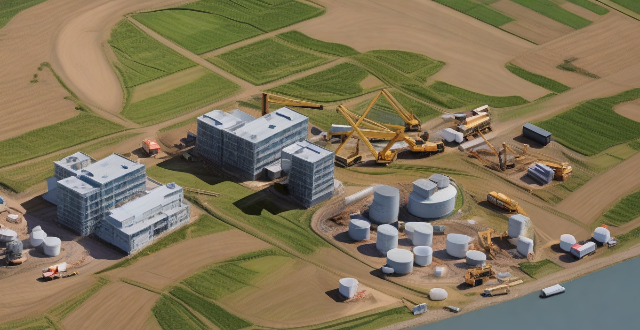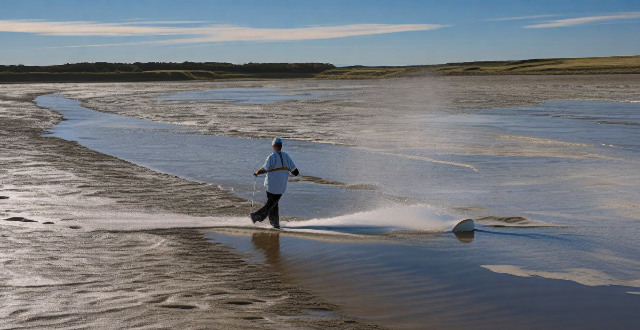Water Flood

What role do wetlands play in water purification and flood control ?
In summary, wetlands are crucial ecosystems that play a vital role in water purification and flood control. They act as natural filters, removing sediments, nutrients, and pollutants from water while also providing buffering capacity for floodwaters. By preserving and restoring wetlands, we can ensure clean water resources and minimize the risks associated with flooding.

How do different countries approach flood control and management ?
Flood control and management strategies vary across different countries, influenced by factors such as geographic location, climate conditions, economic resources, and technological advancements. The United States relies on early warning systems, flood insurance programs, and floodplain zoning regulations. The Netherlands invests in flood barriers and dikes, water management policies, and international cooperation. China focuses on the Three Gorges Dam, flood prevention campaigns, and reforestation efforts. India adopts community-based approaches, integrated water resource management, and disaster risk reduction programs.

What is the importance of wetlands in flood mitigation ?
The text discusses the importance of wetlands in flood mitigation. It highlights their roles as natural reservoirs that store excess water, stabilize soils to prevent erosion, and provide habitat for flood-tolerant species. The article also mentions the benefits of wetlands for human communities, including reduced property damage, improved water quality, and recreational opportunities. Overall, it emphasizes the need to protect and restore wetlands for their crucial role in maintaining a healthy and resilient ecosystem.

How does climate change affect flood control strategies ?
Climate change significantly impacts flood control strategies by altering precipitation patterns, leading to more frequent and severe flooding. This requires adaptations in flood management approaches, including increased infrastructure resilience, ecosystem-based solutions, regulatory adjustments, early warning systems, and community engagement.

What are the most effective flood control measures ?
Effective flood control measures include both structural and non-structural approaches. Structural measures involve the construction of physical barriers such as dams, levees, embankments, dikes, seawalls, floodwalls, and floodgates to prevent or contain floodwaters. Non-structural measures include flood forecasting, early warning systems, land use planning, floodproofing, elevation, flood insurance, financial aid, public awareness campaigns, community drills, volunteer programs, and neighborhood watch programs. These measures work together to mitigate the risks and impacts of flooding, protecting lives and property.

What are some innovative solutions for flood prevention and management ?
The provided text discusses innovative solutions for flood prevention and management, highlighting various strategies such as early warning systems, green infrastructure, smart water management systems, flood barriers and walls, and community engagement and education. Each strategy is briefly explained, emphasizing its key features and benefits in mitigating the impact of floods on lives and property. The conclusion emphasizes the importance of considering local conditions and needs when selecting appropriate measures for effective flood prevention and management.

What role do dams play in flood control ?
Dams are crucial for flood control, providing storageDams are crucial for flood control, providing storage reduction, community preparedness, providing storage, flow regulation, risk reduction, community preparedness, ecological health support, and integrated water resource management.

How can we improve flood forecasting and early warning systems ?
Improving flood forecasting and early warning systems is essential for mitigating the devastating impacts of floods on human lives, properties, and ecosystems. Some strategies to enhance these systems include investing in advanced technology such as satellite imagery, hydrological modeling, and data analytics; improving data collection and sharing through the installation of more gauges and sensors, collaboration with other agencies, and crowdsourcing data; enhancing communication and dissemination of information by establishing multi-channel warning systems, creating community-based warning networks, and providing clear and actionable information; conducting regular maintenance and testing of infrastructure and conducting drills and simulations; and engaging stakeholders and building partnerships with local communities, academic institutions, and international organizations.

How can climate services be used to manage water resources effectively ?
Climate services play a critical role in water resources management by providing accurate and timely information on weather patterns, climate change, and related phenomena. These services can be used to forecast precipitation, monitor river levels for flood early warning systems, assess the impact of climate change on water availability, plan adaptation measures, monitor drought conditions, manage water quality, and protect ecosystems. By leveraging these services, we can ensure the effective use of water resources, adapt to changing climates, prepare for extreme weather events, and guarantee a sustainable water supply for future generations.

In what ways do dams and reservoirs affect downstream water ecosystems ?
Dams and reservoirs significantly alter downstream water ecosystems by changing water flow, trapping sediments, disrupting nutrient cycles, fragmenting habitats, and affecting biodiversity.

How does climate change impact water resource management ?
Climate change significantly impacts water resource management by altering precipitation patterns, increasing evaporation rates, and changing runoff patterns. These changes lead to more variable rainfall, prolonged droughts or intense flooding, reduced snowpack, and earlier spring runoff, among other effects. To adapt, strategies such as water conservation, infrastructure upgrades, integrated planning, ecosystem restoration, and improved monitoring and forecasting are essential for ensuring sustainable water resources amidst a changing climate.

How can we prevent flooding in urban areas ?
Flooding in urban areas is a pressing issue that calls for multifaceted solutions. The strategies include enhancing infrastructure resilience through green infrastructure development, improved drainage systems, and structural flood protection measures. Risk management and early warning systems are also crucial, encompassing risk assessment, community participation, hydrological monitoring, weather forecasting technology, and public alert systems. Emergency response plans involving evacuation routes, temporary shelters, and rescue services coordination further strengthen the overall approach. A combination of structural and non-structural strategies is recommended for effective adaptation to rising flood risks. Urban planners, engineers, and policymakers must collaborate to create cities that are resilient, safe, and capable of handling climate change's uncertainties.

How do changing precipitation patterns influence water resources management ?
The text discusses the impact of changing precipitation patterns on water resources management, which involves the regulation and allocation of water for various uses like drinking, irrigation, industrial processes, and ecosystem maintenance. The key points include precipitation variability, water resources management, and climate change impacts. The changing precipitation patterns can lead to unpredictability in water availability, infrastructure stress, agricultural water needs, ecosystem health, urban water use, and policy and legislation changes. To cope with these impacts, mitigation measures such as reducing greenhouse gas emissions, rainwater harvesting, and water conservation practices can be implemented. Adaptation measures include flexible water allocation systems, infrastructure upgrading, integrated water resources management, and ecosystem restoration. The conclusion emphasizes the need for proactive planning, investment in resilient infrastructure, and the adoption of innovative practices that promote sustainability and flexibility in the face of an uncertain future.

What are the key challenges in managing water resources sustainably ?
Managing water resources sustainably is a complex task that involves various challenges, including climate change, population growth and urbanization, pollution and degradation of water bodies, overexploitation and unsustainable use, inadequate governance and policy frameworks, economic and financial constraints, social and cultural factors, technological limitations, ecological considerations, and international water sharing. Addressing these challenges requires a combination of technological innovation, policy reform, public education, and international cooperation. Sustainable water management is not only about ensuring enough water for current needs but also about preserving this vital resource for future generations.

What are the legal and policy frameworks for water resource management at the national and international levels ?
Water resource management is a critical issue that affects the sustainability of ecosystems, the economy, and human well-being. To address this challenge, various legal and policy frameworks have been established at both national and international levels. At the national level, water resource management is governed by a combination of laws, regulations, and policies aimed at ensuring equitable access to water resources, protecting the environment, and promoting sustainable development. International legal and policy frameworks play a crucial role in addressing transboundary water issues and promoting global cooperation on water resource management. Effective water resource management requires a comprehensive approach that encompasses both national and international legal and policy frameworks.

How do changes in precipitation patterns influence urban drainage and water management systems ?
Changes in precipitation patterns, often linked to climate change, have significant implications for urban drainage and water management systems. These alterations can lead to increased frequency and intensity of storm events, which places a strain on existing infrastructure and necessitates adaptation strategies. Key considerations include increased storm intensity and frequency, the urban heat island effect, runoff management, water quality concerns, and ecosystem impacts. Strategies for adaptation include green infrastructure, rainwater harvesting, decentralized water management, stormwater regulations, integrated water resource management, smart technology, community engagement, and sustainable drainage systems. The shifts in precipitation patterns demand a comprehensive approach to urban drainage and water management that emphasizes resiliency, sustainability, and adaptability. By integrating innovative technologies, green infrastructure, and community participation, cities can better cope with these changes and safeguard their environments and populations from the adverse effects of extreme weather events.

How does deforestation contribute to water cycle disruption ?
Deforestation contributes to water cycle disruption through soil erosion, surface runoff, and groundwater depletion. This leads to droughts, flooding, pollution, water scarcity, and climate change. Sustainable forest management is crucial to mitigate these effects.

What are the economic impacts of floods and how can they be minimized ?
Floods have significant economic impacts on communities, affecting various sectors of the economy. Direct impacts include property damage, crop loss, and business disruption, while indirect impacts encompass job losses, population displacement, and economic downturns. To minimize these effects, strategies such as flood defense infrastructure, early warning systems, emergency plans, flood insurance, microfinance, land-use planning, building codes, public awareness campaigns, and capacity building are recommended. By adopting a comprehensive approach, communities can enhance their resilience and reduce the economic repercussions of flooding.

How effective are large-scale water transfer projects in alleviating water scarcity ?
Water scarcity is a global issue, and large-scale water transfer projects aim to alleviate it by transporting water from areas with abundant resources to those with scarce ones. These projects can increase water availability, diversify water sources, and provide environmental benefits such as restoring depleted aquifers and wetlands. However, they also face challenges like high costs, negative environmental impacts, and social and political issues. To maximize the benefits of these projects while minimizing their drawbacks, careful consideration of their potential consequences and involvement of all relevant stakeholders in the decision-making process are essential.

How can we improve water resource management in our community ?
The article discusses the importance of water resource management in our community and suggests various strategies to improve it. These include raising awareness through educational campaigns, implementing water-saving measures like fixing leaks and using low-flow fixtures, upgrading infrastructure such as wastewater treatment plants, promoting sustainable practices like xeriscaping and green roofs, and fostering collaborative efforts among different stakeholders. By adopting these approaches, we can ensure the long-term availability of clean water while protecting the environment.

How does rainwater harvesting contribute to environmental sustainability ?
Rainwater harvesting contributes to environmental sustainability by reducing water consumption, enhancing soil health and erosion control, mitigating flood risks, reducing pollution, and promoting biodiversity. By collecting and using rainwater for various purposes such as irrigation, cleaning, and even drinking, we can significantly reduce our reliance on municipal water supplies. This helps conserve freshwater resources and reduces the energy required to treat and transport water from sources to our homes and businesses. Rainwater harvesting also enhances soil health by allowing rainwater to soak into the ground instead of running off into storm drains, which helps replenish groundwater reserves and improves soil moisture levels. Additionally, capturing and storing rainwater on site can reduce the amount of water that enters storm drains during heavy rainfall events, alleviating pressure on urban drainage systems and reducing the risk of flooding in low-lying areas or areas with poor drainage. Furthermore, rainwater harvesting reduces pollution by preventing pollutants such as fertilizers, pesticides, and other chemicals from entering local waterways when rainwater is collected and used instead of being allowed to flow into storm drains. Finally, rainwater harvesting promotes biodiversity by creating habitats for native plants and animals through the creation of rain gardens, bioswales, and other green infrastructure projects.

What are the key sectors that need to focus on climate adaptation ?
The key sectors that need to focus on climate adaptation include agriculture, forestry, coastal areas, water resources, and energy production. In agriculture, crop diversification, water management, and soil conservation are crucial practices. In forestry, sustainable forest management, fire prevention, and biodiversity conservation are essential. Coastal protection, ecosystem restoration, and fisheries management are critical in coastal areas. Water conservation, flood control, and groundwater management are vital for water resources. Finally, investing in renewable energy, improving energy efficiency, and developing carbon capture and storage technologies are crucial for energy production. By focusing on these sectors, we can build resilience against climate change and ensure a sustainable future.

How does climate change affect water resources and availability ?
Climate change affects water resources and availability through melting glaciers, changes in precipitation patterns, sea level rise, increased evaporation rates, and impacts on ecosystems. These impacts can lead to water scarcity, flooding, contamination of freshwater sources, and declines in biodiversity. To mitigate these effects, it is important to reduce greenhouse gas emissions and implement adaptation strategies such as improved water management and conservation measures.

How can we balance economic development and water resource protection ?
Water resources are crucial for economic development but must be protected to ensure sustainability. Strategies for balancing these goals include prioritizing sustainable practices, implementing regulatory measures, fostering collaboration and partnerships, investing in infrastructure and technology, and educating and creating awareness. By adopting these approaches, we can achieve a balance between economic growth and water conservation, ensuring long-term sustainability for all.

What are some effective strategies for teaching water safety to children ?
Water safety is an essential skill that every child should learn, especially during the summer months when they are more likely to be around water. Here are some effective strategies for teaching water safety to children: Start early, set clear rules, use visual aids, practice makes perfect, role playing, stay close and supervised, teach risk assessment, and be a good example.

How can I reduce my electricity and water bills ?
To reduce electricity and water bills, one should switchTo reduce electricity and water bills, one should switch, adjust habits like turning off install water-saving fixtures, change bathroom habits, optimize garden watering, and be efficient with laundry and dishes.

How does climate change affect the quality and availability of drinking water ?
This article discusses the various ways in which climate change affects the quality and availability of drinking water, including changes in precipitation patterns, melting glaciers, sea level rise, temperature increase, extreme weather events, and wildfires. It also explores adaptation strategies such as water conservation measures, infrastructure improvements, protection of water sources, and policy and regulation to mitigate these risks and ensure a sustainable water future for all.